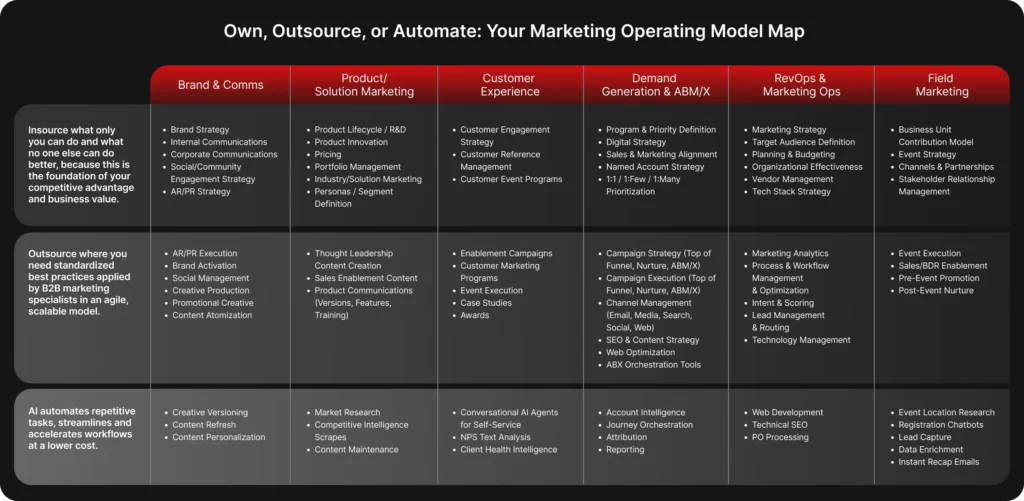June 19, 2025 | Blog
The “Own, Outsource, Automate” framework: Redefine marketing roles, accelerate execution, and scale smarter.

A new operating model for marketing leaders and the marketers who make it work.
If you’re a CMO today, you’re being asked to do the impossible. Deliver more impact with less headcount. Move faster with fewer resources. Hit bigger goals with a flatter team.
It’s not just difficult. It’s unsustainable under traditional models.
That’s why the most effective marketing organizations are rethinking how the work gets done. They’re shifting from asking “how do we do more?” to “how do we redesign the way the work happens?”
And at the heart of that transformation is a new decision-making lens: What should we keep in-house, what should we outsource, and what should we automate?
We call this the “Own, Outsource, Automate” framework.
For marketing leaders: Architect the model, don’t shoulder the load
As a marketing leader, your role is not to absorb work. It’s to design a system that delivers results.
That means making strategic decisions about ownership, not just who does the work, but why, where, and how it gets done. Here’s how we break down the modern model: at drive pipeline and business growth.
Own it
These are the capabilities that drive your differentiation. They’re close to the business, close to the customer, and closely tied to your strategic narrative.
This is the work you keep in-house.
Common examples:
- Brand narrative
- Product positioning
- Strategic go-to-market plans
- Executive and cross-functional alignment
- Messaging architecture
- Category definition and leadership
- Buyer and customer insight synthesis
If the work defines how you win, you don’t delegate it.
Outsource it
This is where most of the marketing execution happens. It requires skill, precision, and platform fluency, but not deep institutional context.
This is where you leverage embedded specialists, managed services, or agency partners to execute with excellence, while you retain accountability and strategic oversight.
Examples include:
- Campaign operations
- Email marketing
- Paid media execution
- Search strategy
- Localization and transcreation
The difference here is control without overreach. You direct the outcome, but you’re not the one pulling every lever.
Automate it
Some work doesn’t require people, it requires precision. If it’s rules-based, repeatable, and doesn’t drive unique strategic value, it can likely be automated.
Automation lets you eliminate drag and refocus human effort where it matters most.
- Data enrichment
- UTM parameter generation
- Metadata QA
- Budget reconciliation
- Report distribution
- Deck formatting
- Internal brief processing
AI becomes a capacity amplifier, not just a cost-saving lever.
But what if your team isn’t ready for this shift?
That’s where this model gets personal.
Because even when the strategic rationale is clear, the emotional reality is not. Many marketers, especially high-performing execution leaders, hear “outsourcing” or “automation” and immediately brace for loss.
They don’t say it out loud, but you can feel it:
What if I lose the work I’m good at?
What if no one else does it right?
What if I’m replaced by a tool or a cheaper resource?
These are valid, deeply human reactions. But they’re also outdated assumptions about how growth happens.
For marketers: You’re not being replaced. You’re being refocused.
If you’ve built your career on being the go-to person who gets things done, this shift may feel disorienting. You’ve created value through reliability, through speed, through execution. And now you’re being asked to step back?
Not exactly.
You’re being asked to step up.
This is the moment where tactical doers evolve into strategic operators. Not by working harder, but by working differently.
Here’s what that shift unlocks:
- You move closer to the business. Instead of producing assets, you’re solving problems. Instead of building slides, you’re shaping the story inside them.
- You become a multiplier, not a throughput machine. By orchestrating work instead of shouldering all of it, you start driving outcomes, not just activity.
- You grow by leading through others. Executional excellence doesn’t disappear. It becomes part of your playbook for managing, scaling, and enabling.
- You build credibility beyond your channel. You’re no longer the “email person” or “search lead,” you’re a marketing operator who sees across the system.
Letting go of certain tasks isn’t giving up control. It’s reclaiming your focus. It’s how you go from essential to elevated.
How to decide what belongs where
When you’re evaluating any function or task, ask yourself:
Does this drive strategic differentiation?
If yes, own it.
Does this require skill and best-practice execution, but not deep company context?
If yes, orchestrate it through a partner.
Is this repetitive, process-driven, or rule-based?
If yes, automate it.
A sample mapping of common marketing work

Note: In many cases, outsourcing and automation work together. The point is not to rigidly assign tasks to boxes but to choose the right model for each function based on value, complexity, and strategic relevance.
Final word: Marketing work is changing. Your role can evolve with it.
For CMOs, this model is about building systems, not running on fumes. Your job is to build the blueprint that makes consistent impact possible at scale.
For marketers, this model is an opportunity, not a threat. Letting go of the repetitive work creates room for more interesting problems, deeper collaboration, and accelerated growth.
Own what differentiates.
Outsource what can scale with expertise.
Automate what distracts, delays, or drags.
That’s how you evolve your operating model, without losing your people or your power.
Let us know when you’re ready to make that shift.



